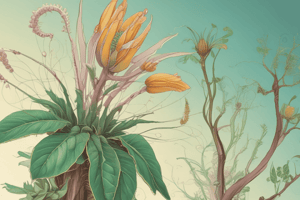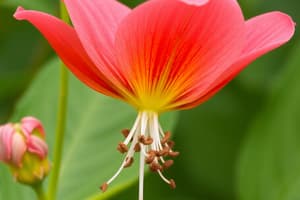Podcast
Questions and Answers
Which of the following is the correct sequence of development in angiosperm sexual reproduction?
Which of the following is the correct sequence of development in angiosperm sexual reproduction?
- Megasporogenesis → Pollination → Fertilisation → Embryogenesis
- Pollination → Fertilisation → Megasporogenesis → Embryogenesis
- Megasporogenesis → Fertilisation → Pollination → Embryogenesis
- Pollination → Megasporogenesis → Fertilisation → Embryogenesis (correct)
In a bilobed anther, what is the arrangement of microsporangia?
In a bilobed anther, what is the arrangement of microsporangia?
- One microsporangium in each lobe
- Two microsporangia in each lobe (correct)
- Three microsporangia in each lobe
- Four microsporangia in each lobe
What structural feature of pollen grains enables them to withstand harsh environmental conditions?
What structural feature of pollen grains enables them to withstand harsh environmental conditions?
- Cellulose intine
- Mucilaginous covering
- Pectin intine
- Sporopollenin exine (correct)
What is the fate of the polar nuclei after fertilisation in angiosperms?
What is the fate of the polar nuclei after fertilisation in angiosperms?
How does the process of geitonogamy differ from xenogamy in flowering plants?
How does the process of geitonogamy differ from xenogamy in flowering plants?
Which of the following events is NOT an example of an outbreeding device in flowering plants?
Which of the following events is NOT an example of an outbreeding device in flowering plants?
In the context of artificial hybridisation, what is the purpose of 'bagging' the emasculated flower?
In the context of artificial hybridisation, what is the purpose of 'bagging' the emasculated flower?
What is the primary function of the endosperm in angiosperm seeds?
What is the primary function of the endosperm in angiosperm seeds?
What distinguishes a 'true fruit' from a 'false fruit'?
What distinguishes a 'true fruit' from a 'false fruit'?
In which of the following scenarios would apomixis be most agriculturally advantageous?
In which of the following scenarios would apomixis be most agriculturally advantageous?
Flashcards
Microsporogenesis
Microsporogenesis
The process of formation of microspores from a pollen mother cell (PMC) through meiosis, occurring inside the anther.
Sporopollenin
Sporopollenin
A tough, resistant polymer in pollen grain exines that protects against environmental damage.
Autogamy
Autogamy
Self-pollination, transfer of pollen grains from anther to stigma within the same flower.
Geitonogamy
Geitonogamy
Signup and view all the flashcards
Xenogamy
Xenogamy
Signup and view all the flashcards
Outbreeding Devices
Outbreeding Devices
Signup and view all the flashcards
Artificial Hybridisation
Artificial Hybridisation
Signup and view all the flashcards
Double Fertilisation
Double Fertilisation
Signup and view all the flashcards
Seed Coat
Seed Coat
Signup and view all the flashcards
Apomixis
Apomixis
Signup and view all the flashcards
Study Notes
- Sexual Reproduction in Flowering Plants
Pre-fertilisation: Structures and Events
- Prior to fertilisation, floral primordium develops, followed by the differentiation and development of floral structures (stamens and pistils).
The Flower
- A flower consists of four whorls: calyx, corolla, androecium, and gynoecium.
- Androecium and gynoecium are the reproductive organs.
- A typical stamen consists of a filament and an anther.
- The anther is usually bilobed, with each lobe containing two theca (dithecous).
- Anther Structure: It has four microsporangia located at the corners, two in each lobe.
- Microsporangia develop further and become pollen sacs, containing pollen grains.
- Microsporogenesis: It is the process of formation of microspores from a pollen mother cell (PMC) through meiosis.
- As the anther matures, the microspores separate and develop into pollen grains.
- Pollen grains represent the male gametophytes.
- Pollen grains have a two-layered wall: the exine (outer, made of sporopollenin) and the intine (inner, made of cellulose and pectin).
- Sporopollenin: It is a resistant organic material that can withstand high temperatures, strong acids, and alkalis.
- The germ pore is an aperture on the exine where sporopollenin is absent, allowing the pollen tube to emerge.
- Pollen grains are shed at a 2-celled stage (vegetative and generative cell) in most angiosperms.
- In some species, pollen grains are shed at a 3-celled stage (vegetative cell and two male gametes).
- Pollen grains of some plants cause allergies and respiratory problems.
- Pollen viability varies from plant to plant; some retain viability for months, while others for only 30 minutes.
- Pollen grains can be stored in liquid nitrogen (-196°C) in pollen banks.
The Pistil, Megasporangium (Ovule) and Embryo Sac
- The pistil represents the female reproductive part of the flower and may consist of a single carpel (monocarpellary) or multiple carpels (multicarpellary).
- Syncarpous: Condition where carpels are fused.
- Apocarpous: Condition where carpels are free.
- Each pistil has three parts: stigma, style, and ovary.
- The ovules are present inside the ovary.
- Megasporangium (Ovule): A typical ovule consists of a funicle (stalk), hilum (junction between ovule and funicle), integuments (protective layers), nucellus (tissue enclosing the embryo sac), and chalaza (basal part).
- The embryo sac is located within the nucellus.
- Megasporogenesis: The process of formation of megaspores from the megaspore mother cell (MMC) through meiosis.
- Usually, one megaspore is functional, while the other three degenerate.
- The functional megaspore develops into the female gametophyte (embryo sac).
- Megagametogenesis: The development of the embryo sac from a single functional megaspore.
- The nucleus of the functional megaspore divides mitotically to form two nuclei, which move to opposite poles, forming a 2-nucleate embryo sac.
- Subsequent mitotic divisions result in 4-nucleate and 8-nucleate stages.
- The 8-nucleate embryo sac organizes with six nuclei surrounded by cell walls and the remaining two (polar nuclei) fusing to form the secondary nucleus in the central cell.
- The egg apparatus consists of one egg cell and two synergids, located at the micropylar end.
- Antipodals are three cells present at the chalazal end.
- A typical angiosperm embryo sac at maturity is 8-nucleate and 7-celled.
Pollination
- Pollination is the transfer of pollen grains from the anther to the stigma.
- Autogamy: Self-pollination within the same flower.
- Geitonogamy: Transfer of pollen grains from the anther of one flower to the stigma of another flower on the same plant.
- Xenogamy: Transfer of pollen grains from the anther of one flower to the stigma of a different plant.
- Agents of Pollination: Abiotic (wind, water) and biotic (animals).
- Anemophily: Pollination by wind.
- Hydrophily: Pollination by water.
- Zoophily: Pollination by animals (insects, birds, bats, etc.).
- Adaptations in flowers for different pollination methods:
- Wind-pollinated flowers: small, non-showy, produce large quantities of pollen, light, and non-sticky pollen grains.
- Water-pollinated flowers: small, inconspicuous, pollen grains protected by a mucilaginous covering.
- Insect-pollinated flowers: large, colorful, fragrant, nectar-rich.
- Outbreeding Devices: Mechanisms to prevent self-pollination and promote cross-pollination:
- Dichogamy (pollen release and stigma receptivity not synchronized).
- Self-incompatibility (genetic mechanism preventing self-pollination).
- Herkogamy (physical barrier preventing self-pollination).
- Production of unisexual flowers.
Pollen-Pistil Interaction
- Pollen-pistil interaction involves the recognition of pollen by the stigma, followed by promotion or inhibition of pollen tube growth.
- Compatible pollen grains germinate on the stigma and grow through the style to reach the ovule.
- The pollen tube enters the embryo sac through the micropyle and releases two male gametes.
Artificial Hybridisation
- Artificial hybridisation is a method to improve crop varieties by crossing different plants.
- Process involves emasculation (removal of anthers) and bagging (covering the stigma to prevent contamination).
- Desired pollen is dusted on the stigma, and the flower is rebagged to allow fruit development.
Double Fertilisation
- Double fertilisation is a unique event in angiosperms involving two fusions.
- One male gamete fuses with the egg cell to form a zygote (syngamy).
- The other male gamete fuses with the polar nuclei to form the primary endosperm nucleus (PEN) in the central cell (triple fusion).
- The PEN develops into the endosperm, which provides nourishment to the developing embryo.
Post-fertilisation: Structures and Events
- Following fertilisation, the zygote develops into the embryo, the ovule develops into the seed, and the ovary develops into the fruit.
Endosperm
- Endosperm development usually precedes embryo development.
- The primary endosperm cell divides repeatedly to form a triploid endosperm tissue.
- Endosperm may be completely consumed by the developing embryo (e.g., pea, groundnut) or persist in the mature seed (e.g., castor, coconut).
- Types of endosperm development: Nuclear, Cellular, and Helobial.
Embryo
- The zygote divides to form the proembryo, which then develops into the embryo.
- A typical dicot embryo consists of an embryonal axis and two cotyledons.
- The epicotyl (plumule) is the portion of the embryonal axis above the cotyledon attachment.
- The hypocotyl (radicle) is the portion below the cotyledon attachment.
- A typical monocot embryo has one cotyledon (scutellum), a coleorhiza (protective sheath covering the radicle), and a coleoptile (protective sheath covering the plumule).
Seed
- The seed is the fertilised ovule.
- Seed Coat: It is formed from the integuments of the ovule.
- Micropyle: it facilitates entry of oxygen and water into the seed during germination.
- Hilum: Scar on the seed coat where it was attached to the fruit.
- Albuminous seeds: Seeds that retain a part of the endosperm (e.g., wheat, maize, barley).
- Non-albuminous seeds: Seeds that do not retain any endosperm (e.g., pea, groundnut).
- Perisperm: Remnant of nucellus in some seeds (e.g., black pepper, beet).
- Seed dormancy: A state of inactivity, helping to survive unfavorable conditions.
Fruit
- The fruit is the mature ovary developed after fertilisation.
- The wall of the ovary forms the fruit wall or pericarp.
- True fruits develop only from the ovary.
- False fruits develop from other floral parts along with the ovary (e.g., apple, strawberry).
- Parthenocarpic fruits develop without fertilisation (e.g., banana).
Apomixis and Polyembryony
- Apomixis: A form of asexual reproduction that mimics sexual reproduction, where seeds are produced without fertilisation.
- Polyembryony: The occurrence of more than one embryo in a seed (e.g., citrus, mango).
Studying That Suits You
Use AI to generate personalized quizzes and flashcards to suit your learning preferences.




